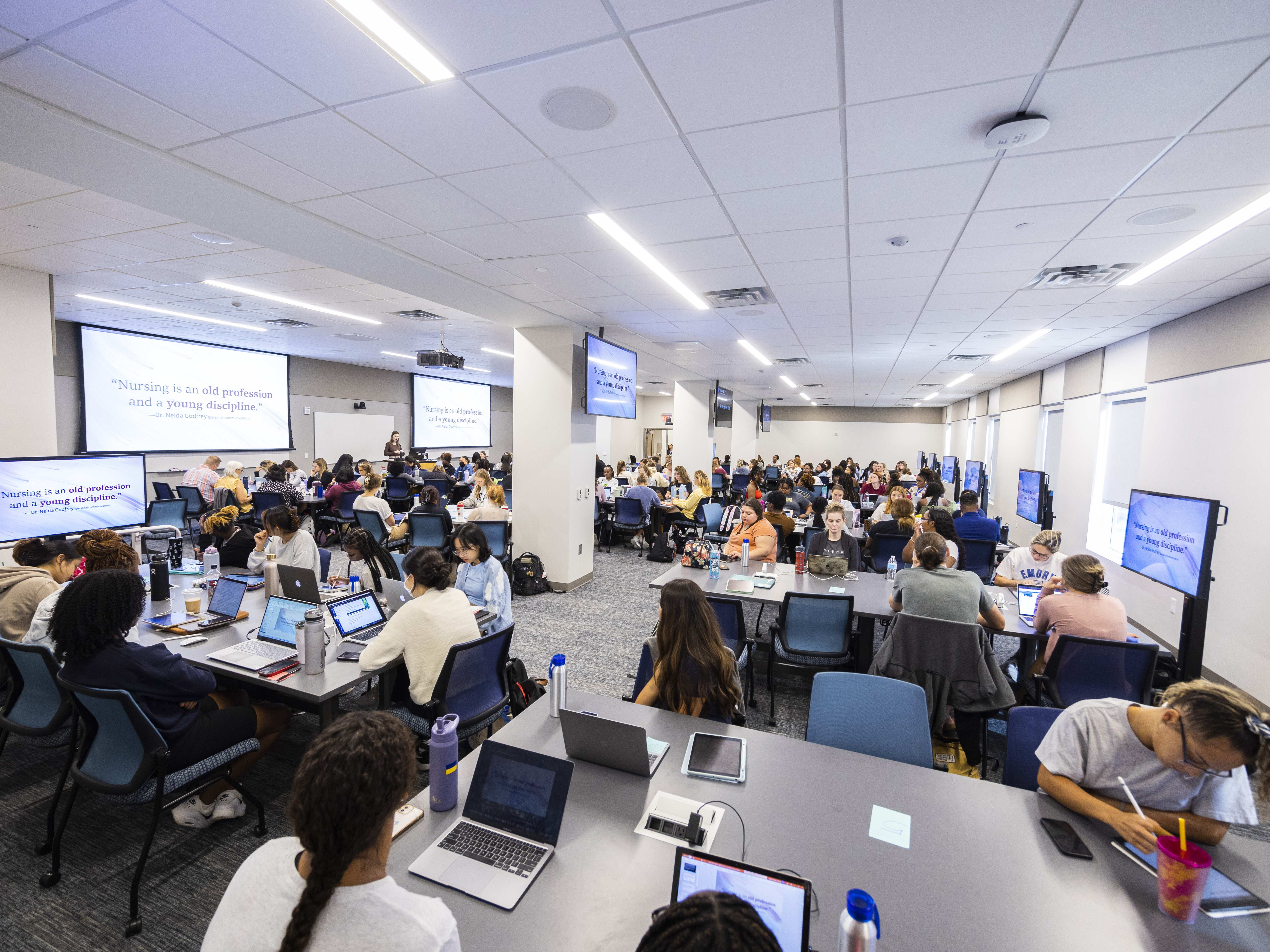Space Just for Students

As nursing faculty and alumni will tell you, students can never have too much classroom, study, and chill-out space. The second floor of the Emory Nursing Learning Center is designed to meet those needs.
Around the corner from the Innovation Hub are three flexible classroom spaces, all equipped with interactive technology to create an active learning environment for students. Two smaller classrooms seat 45 students each. A large classroom seats up to 150 students, but not in typical theater style. Instead, students are grouped at large tables within easy view of large portable display monitors.
“We designed this classroom for peer-to-peer learning,” says Tricia Benson, 86MN, who helped guide how learning center spaces would be used. “Students will learn from each other as they work on projects and select the best ones to share with the class. The classroom setup will ensure students know how to work collaboratively as part of a clinical team when they begin to practice as nurses.”
Often, before and after classes, students can use the open skills lab to learn and practice on their own. The lab has hospital beds, tables, chairs, and adult, child, and infant manikins. It is named for the late Charles F. and Peggy Evans, whose bequest in 2003 made clinical skills and simulation learning possible at the 1520 Clifton Road building.
The second floor features a variety of other spaces just for students: a lounge, a wellness and meditation room, a room for nursing mothers, and a study area and outdoor balcony. It also includes a home lab with data collection capability resembling a small apartment, a telehealth office, conference rooms, and touchdown space for faculty, appointed with original wood paneling.
PAYING IT FORWARD
Emory nursing alumni are bound by the rewards and challenges they experienced in nursing school. Several spaces on the second floor are named for alumni whose gifts are intended to make the path easier for current and future nursing students.
Donté Flanagan, 04OX, 06N, 10MSN, DNP, is a certified registered nurse anesthetist who lives with his family in Philadelphia, Pennsylvania. He still recalls how daunting nursing school can be, especially for students who are underrepresented because of race, ethnicity, or gender. He and his wife, Ashlee, made a gift to name the student lounge in that spirit. They see the Flanagan Solidarity Lounge “as a place for students, especially those with marginalized identities, to feel safe and inspired to learn, achieve, and excel,” says Donté.

The large classroom features high-tech monitors and group seating to foster collaborative learning.
Mary McCabe, 72N, MA, devoted her career to improving survivorship for patients at Memorial Sloan Kettering Cancer Center in Manhattan. As an undergraduate nursing student at Emory, she found it difficult at times to find a quiet, relaxing place to study. In that spirit, she made a gift to name the Mary and Thomas McCabe Student Study Area and Balcony.
“It seems ideal to me to have an informal place for students to spend time in solitary study or collaborative learning,” says McCabe. “Having such space is a treasure, and it makes me want to grab my laptop and find a seat!”
Tucked between the study area and a student locker room is a new mothers room named for Rose Cannon, 74MN, 95PhD. Her gift stems from her 37-year career in maternal and newborn practice and education at Emory’s nursing school.
Nancy Langston, 72N, PhD, FAAN, ANEF, retired dean of the Virginia Commonwealth School of Nursing, knows what it’s like to open a new building. She oversaw planning and construction of a four-level building, which had plenty of open spaces for nursing students. After the building opened, she learned that some students preferred quiet, closed spaces for studying, often in an unoccupied classroom.
Toward that end, she designated a gift for the Langston– McCain Conference Room on the second floor of the new learning center. “Given the opportunity to support a space that I knew from past experience would be put to good use by individuals and small groups of students, I was sold on the idea,” says Langston.








